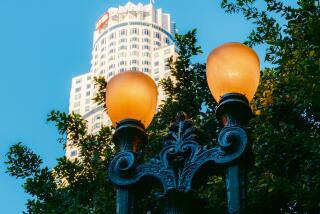CCDC Seeks Exemption to Amber Street Lights for Gaslamp Quarter
- Share via
Claiming that low-pressure sodium lighting is a poor choice for a “revitalizing downtown,” Centre City Development Corp. (CCDC) directors voted Friday to ask the City Council to exempt San Diego’s redevelopment area from using amber-colored street lights.
The City Council voted to require low-pressure sodium lighting, referred to by opponents as “bug lights,” in all areas a year ago after astronomers at nearby observatories complained that light pollution was hampering their research.
The council had earlier chosen the high-pressure sodium lights because they are considerably cheaper to operate than the mercury vapor street lamps the city then had.
The redevelopment agency earlier had applied for an exemption permitting high-pressure sodium lights, but it was denied. Now, CCDC officials are proposing a compromise--use of mercury vapor street lights for downtown. The mercury vapor lighting is brighter than low-pressure lighting and interferes less than high-pressure lighting with astronomers’ research.
CCDC Assistant Vice President Pam Hamilton said her firm is concerned that the yellowish low-pressure sodium lights, which are technically as bright as other types of lights but have much poorer color rendition, might keep people from visiting the Gaslamp Quarter redeveloped areas.
“Perception is often more important than reality,” Hamilton said. “The lighter, brighter environment (of the mercury vapor lights) would be more likely to make people want to get out of their cars and walk around.”
In its recommendation to the city, CCDC emphasized that light pollution is much less of a problem with the mercury vapor street lamps than with the high-pressure sodium type.
Contacted after the meeting, astronomer Robert Brucato, assistant director of Palomar Observatory and one of the leading lobbyists for the low-pressure sodium light requirement, confirmed the CCDC evaluation.
“We would prefer that they would use low-pressure sodium, because it is not as dangerous as high-pressure sodium, but mercury vapor is much less dangerous than high-pressure sodium,” Brucato said. “So, I don’t think I’ll go down to the City Council and oppose this.”
But even without the objections of astronomers, CCDC’s proposal still faces a major hurdle in the City Council: price. Mercury vapor street lamps use more than twice the electricity that low-sodium lights use.
Although 62% of the expense of downtown street lights is borne by property owners through assessment districts, the city would still have to pay the rest. But, Hamilton said, CCDC is still confident of receiving an exemption from the city lighting law.
“My opinion is that it’s the city’s downtown, too,” she said. “I think that if the city has to absorb some of these extra costs, it would be in their best interests.”
The remaining obstacle may be the belief of some council members that if one area is granted an exemption, the city would be bound to exempt other areas as well.
“Frankly, I think that’s why we were turned down in the past,” Hamilton said. “My feeling is the council members have some empathy for downtown, but every time we try to get an exemption, they get barraged.
“I can’t imagine the council really wants low-pressure sodium installed in Horton Plaza park, but that’s what we’re going to have to do unless the policy is changed.”
More to Read
Sign up for Essential California
The most important California stories and recommendations in your inbox every morning.
You may occasionally receive promotional content from the Los Angeles Times.













